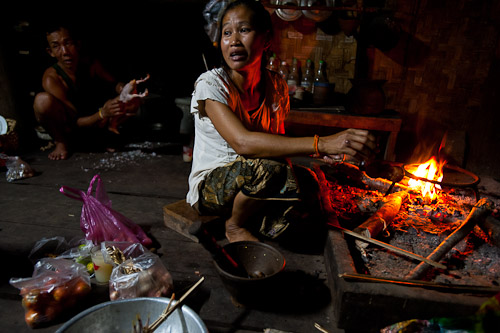 More and more communities in rural Laos are opening up their doors to foreign visitors in the form of homestays. Ban Hat Khai, a village located at the edge of Phu Khao Khuai National Protected Area, in central Laos, is an example of this. I spent a night with a family there a week or so ago, and in addition to meeting some very nice people and gaining an insight into rural Lao life, I also got to witness some Lao food made firsthand. The resulting three dishes comprised one of the better meals I had in Laos.
More and more communities in rural Laos are opening up their doors to foreign visitors in the form of homestays. Ban Hat Khai, a village located at the edge of Phu Khao Khuai National Protected Area, in central Laos, is an example of this. I spent a night with a family there a week or so ago, and in addition to meeting some very nice people and gaining an insight into rural Lao life, I also got to witness some Lao food made firsthand. The resulting three dishes comprised one of the better meals I had in Laos.
The first recipe I witnessed is essentially a 'dip' of grilled tomatoes that is as simple as it is delicious, and is also very Lao. The second two dishes took full advantage of two live ducks picked up at the market. On previous visits to Laos I hadn't really noticed how fond the Lao are of duck, but on this trip I seemed to see it everywhere, particularly grilled, which other than Bali, where I think it's technically roasted, is something haven't really encountered elsewhere in Southeast Asia.
Jaew Mak Len
Tomatoes, 4
Medium-sized chilies, 5
Shallots, 5
Garlic, 2 small heads
Salt, to taste
Fish sauce, to taste
Cilantro, green onion, chopped
Skewer the tomatoes and grill over a coals until the exterior is slightly charred and the inside is tender. Toss the chilies, shallots and garlic directly into the coals. When slightly burnt on the outside and soft inside, remove from coals, and along with the tomato, peel off all the burnt bits. In a mortar and pestle, pound grilled ingredients together into a rough paste/dip and season to taste with salt and fish sauce (and MSG, if desired). Garnish with chopped cilantro and green onion and serve with sticky rice and par-boiled vegetables such as green beans or cabbage.
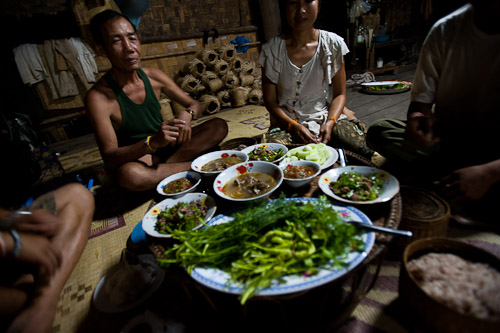
Tom Pet and Laap Pet
Ducks, 2
Ginger, peeled and sliced, one 5cm section
Galingale, peeled and sliced, one 5cm section
Shallots, peeled, 6
Chillies, red, 3
Lemongrass, bruised, 2 stalks
MSG, to taste
Fish sauce, to taste
Small sour tomatoes, halved, 10
Young tamarind leaves
Cilantro, one small bunch, chopped
Phak hom laap (a local herb; substitute with mint), equal to amount of cilantro, chopped
Green onions, 4 stalks, chopped
Shallots, 4, sliced
Khao khua (ground roast sticky rice), about 2 Tbsp
Fish sauce, to taste
MSG, to taste
Lime juice, to taste
Kill ducks. Remove innards and feathers. Joint ducks, separating the bones from the meat. Skewer the meat bits and grill over coals until fully cooked.
For the tom pet, a duck broth, while meat is grilling, bring a large pot of water, enough to accommodate the bones from both ducks, to a boil. Add ginger, galingale, shallots, chilies and lemongrass. Bring to the boil and allow to simmer for about 20 minutes. Season to taste with MSG and fish sauce, add tomatoes and young tamarind leaves. The resulting broth should be equal parts meaty and tart.
For the laap, when the meat is grilled, chop finely and mix with the chopped herbs. Add sliced shallots, khao khua, fish sauce, MSG and lime juice to taste. Serve with a platter of additional fresh herbs (more cilantro, a few sprigs of dill, mint) and sticky rice.
If you're interested in taking part in a homestay in Ban Hat Khai, information on visiting Phu Khao Khuai is available at the Tourist Information Centre in Vientiane.
 Urai, a boat noodle restaurant in Ayuthaya's Sena District, is part of a government-funded scheme called Thong Fah ('Blue Flag') that has established exceedingly cheap restaurants, often serving regional dishes, around the country (Mae Sri Bua in Mae Hong Son is another Thong Fah restaurant I've previously blogged about). I think a bowl of noodles here cost 15 baht (less than 50 cents).
Urai, a boat noodle restaurant in Ayuthaya's Sena District, is part of a government-funded scheme called Thong Fah ('Blue Flag') that has established exceedingly cheap restaurants, often serving regional dishes, around the country (Mae Sri Bua in Mae Hong Son is another Thong Fah restaurant I've previously blogged about). I think a bowl of noodles here cost 15 baht (less than 50 cents).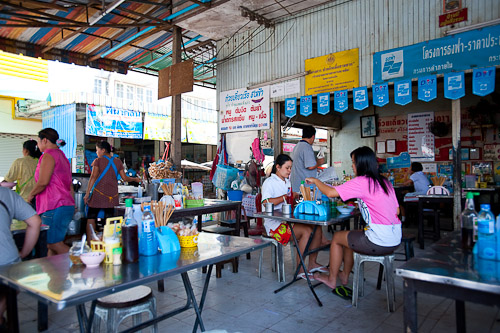
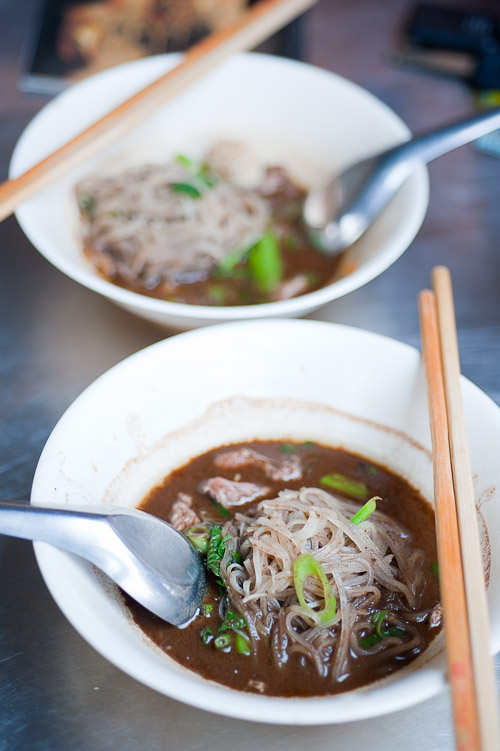












 I'm finally back home after about two months in Laos, and yet again, am craving odd Thai dishes. This time it's kuaytiaw reua (boat noodles), so naturally I headed to the heartland of the dish (and possibly one of the more underrated food cities in Thailand), Ayuthaya.
I'm finally back home after about two months in Laos, and yet again, am craving odd Thai dishes. This time it's kuaytiaw reua (boat noodles), so naturally I headed to the heartland of the dish (and possibly one of the more underrated food cities in Thailand), Ayuthaya.
 It wasn't all sticky rice and grilled meat for the last couple months. Setting out on a road trip to central Laos with my trusty driver Christophe (above, on the left), I picked up a grab bag of French goodies at Les Boutiques Scoubidou, Vientiane's best French deli:
It wasn't all sticky rice and grilled meat for the last couple months. Setting out on a road trip to central Laos with my trusty driver Christophe (above, on the left), I picked up a grab bag of French goodies at Les Boutiques Scoubidou, Vientiane's best French deli:

 More and more communities in rural Laos are opening up their doors to foreign visitors in the form of homestays. Ban Hat Khai, a village located at the edge of
More and more communities in rural Laos are opening up their doors to foreign visitors in the form of homestays. Ban Hat Khai, a village located at the edge of 
 Boat driver on the Nam Kading River, Laos
Boat driver on the Nam Kading River, Laos If you spend enough time on Rte 8, the Lao highway corridor linking Thailand and Vietnam, you’re bound to encounter huge lorries bound for Vietnam carrying cages filled with hundreds of dogs.
If you spend enough time on Rte 8, the Lao highway corridor linking Thailand and Vietnam, you’re bound to encounter huge lorries bound for Vietnam carrying cages filled with hundreds of dogs.
 After more than a month in Vientiane, I have to admit that it's still the case that I've still only been able to find a scant handful of places that do good Lao food. Luckily I live literally around the corner from one that I, not to mention many locals, consider the best place in town.
After more than a month in Vientiane, I have to admit that it's still the case that I've still only been able to find a scant handful of places that do good Lao food. Luckily I live literally around the corner from one that I, not to mention many locals, consider the best place in town.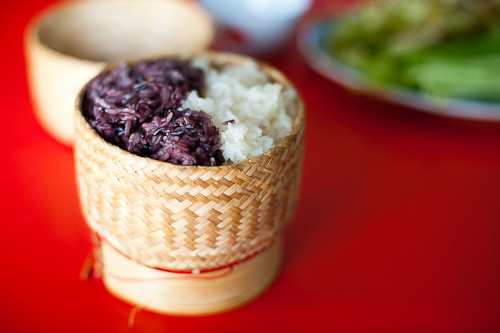





 Watching a pétanque game
Watching a pétanque game Moving back in time slightly, while home a couple weeks ago I also had my first chance to cook in a month: I made cozido à Portuguesa from
Moving back in time slightly, while home a couple weeks ago I also had my first chance to cook in a month: I made cozido à Portuguesa from  Actually this photo could have been taken just about anywhere in Laos; it illustrates a typical scenario that unfolds upon pulling into any rural bus station here. Even before the bus comes to a complete stop, women frantically run to the bus waving sticks of grilled chicken, bags of sticky rice or mangoes, grilled eggs, buckets of drinks and tubes of nyaa dom (nasal inhalers). I don't tend to see too many purchases, but the number of vendors suggests it must be at least a somewhat profitable venture.
Actually this photo could have been taken just about anywhere in Laos; it illustrates a typical scenario that unfolds upon pulling into any rural bus station here. Even before the bus comes to a complete stop, women frantically run to the bus waving sticks of grilled chicken, bags of sticky rice or mangoes, grilled eggs, buckets of drinks and tubes of nyaa dom (nasal inhalers). I don't tend to see too many purchases, but the number of vendors suggests it must be at least a somewhat profitable venture. Am back in Vientiane after an all-too-brief visit to Bangkok followed by a week in the central Lao province of Savannakhet. And what a week it's been... My job at the moment is essentially to walk around towns in Laos and gather information, a task that's been made increasingly difficult by the arrival of summer here in Southeast Asia. Although I've lived in the region for over a decade now, I've only spent a couple summers here, typically having spent this time of year at home in Oregon or Sweden, or somewhere else cool. As a result, the intense heat feels relatively new to me, and is almost unbearable, particularly for one who's walking as much as 10km or more a day. I honestly don't think I've ever sweated so much in my life, but rehydrating in Savannkhet was a literal pleasure, thanks to
Am back in Vientiane after an all-too-brief visit to Bangkok followed by a week in the central Lao province of Savannakhet. And what a week it's been... My job at the moment is essentially to walk around towns in Laos and gather information, a task that's been made increasingly difficult by the arrival of summer here in Southeast Asia. Although I've lived in the region for over a decade now, I've only spent a couple summers here, typically having spent this time of year at home in Oregon or Sweden, or somewhere else cool. As a result, the intense heat feels relatively new to me, and is almost unbearable, particularly for one who's walking as much as 10km or more a day. I honestly don't think I've ever sweated so much in my life, but rehydrating in Savannkhet was a literal pleasure, thanks to 


 Am back home in Bangkok, for a few days anyway, and one of the places I wanted to eat at and blog about was a restaurant I came upon only relatively recently. Tang Jua Lee is a longstanding restaurant in Bangkok's Chinatown, but since undergoing a relatively recent a face-lift, has something of a modern feel:
Am back home in Bangkok, for a few days anyway, and one of the places I wanted to eat at and blog about was a restaurant I came upon only relatively recently. Tang Jua Lee is a longstanding restaurant in Bangkok's Chinatown, but since undergoing a relatively recent a face-lift, has something of a modern feel:






 Seen on a roadside in Vang Vieng, Laos. At first I assumed the bra reference was some sort of not-so-subtle sexy advertising technique, but apparently it's meant literally, and according to
Seen on a roadside in Vang Vieng, Laos. At first I assumed the bra reference was some sort of not-so-subtle sexy advertising technique, but apparently it's meant literally, and according to  Talat laeng, evening markets, are, outside of eating at somebody's home, the best place in Laos to find authentic food. The only downside is that, unless you live there, you'll likely need plates, silverware and a place to eat. But if you can manage this, the below are a couple of the better talat laeng in Vientiane.
Talat laeng, evening markets, are, outside of eating at somebody's home, the best place in Laos to find authentic food. The only downside is that, unless you live there, you'll likely need plates, silverware and a place to eat. But if you can manage this, the below are a couple of the better talat laeng in Vientiane.









 Swensens and the Pizza Company officially opened yesterday in Vientiane. They're the first branches of an international fast-food franchise to open in Laos, although it's worth mentioning that this sort of Western food has been available in Vientiane for a while. At least they didn't pull a China or Russia and put them up near some sacred historical district or monument; the restaurants sit virtually next door to the equally tasteless Lao National Culture Hall.
Swensens and the Pizza Company officially opened yesterday in Vientiane. They're the first branches of an international fast-food franchise to open in Laos, although it's worth mentioning that this sort of Western food has been available in Vientiane for a while. At least they didn't pull a China or Russia and put them up near some sacred historical district or monument; the restaurants sit virtually next door to the equally tasteless Lao National Culture Hall.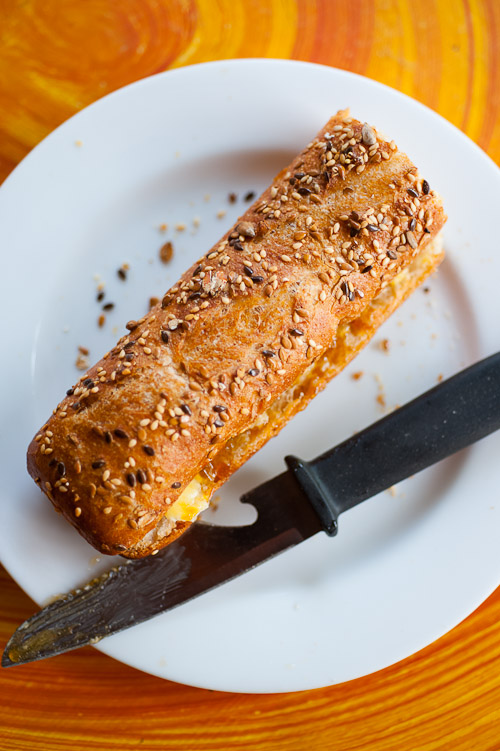 I've been in Vientiane, Laos for the better part of a month now and during this time, my breakfast has hardly diverged from two places. Most days I'll head for Le Banneton, a French bakery in the centre of town. Usually I'll eat in and order their excellent cafe latte (brewed with Lao beans) and a sweet-ish pastry, such as
I've been in Vientiane, Laos for the better part of a month now and during this time, my breakfast has hardly diverged from two places. Most days I'll head for Le Banneton, a French bakery in the centre of town. Usually I'll eat in and order their excellent cafe latte (brewed with Lao beans) and a sweet-ish pastry, such as 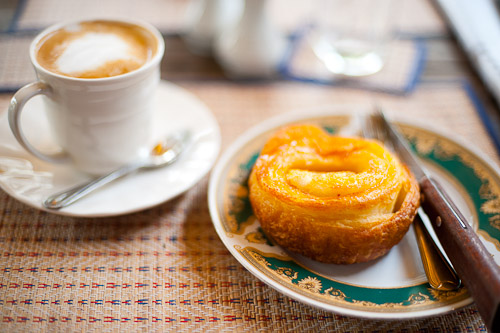
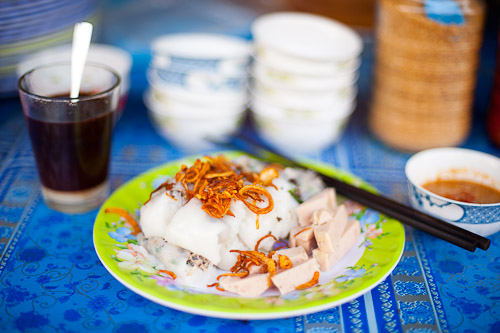
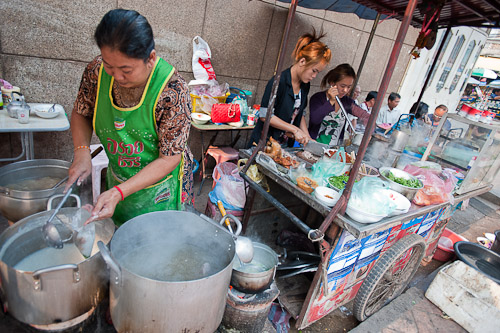
 Sam Euay Nong ('Three Sisters') is a cheery, tidy family-run place in central Vientiane. They do a handful of simple Lao/Vietnamese dishes, ranging from tam mak hung, Lao-style papaya salad, to khao poon nam jaew, thin rice noodles in broth with pork and bamboo, all of which are full of flavour and well executed, but my favourite dish of theirs is probably naem khao.
Sam Euay Nong ('Three Sisters') is a cheery, tidy family-run place in central Vientiane. They do a handful of simple Lao/Vietnamese dishes, ranging from tam mak hung, Lao-style papaya salad, to khao poon nam jaew, thin rice noodles in broth with pork and bamboo, all of which are full of flavour and well executed, but my favourite dish of theirs is probably naem khao.
 Driving along Rte 13 about 25km north of Vang Vieng, I passed by this roadside market, bordered by a stream and shaded by tall limestone cliffs:
Driving along Rte 13 about 25km north of Vang Vieng, I passed by this roadside market, bordered by a stream and shaded by tall limestone cliffs:





 Fishing on the Nam Song, Vang Vieng, Laos
Fishing on the Nam Song, Vang Vieng, Laos Selling CDs near Pha That Luang, Vientiane, Laos
Selling CDs near Pha That Luang, Vientiane, Laos